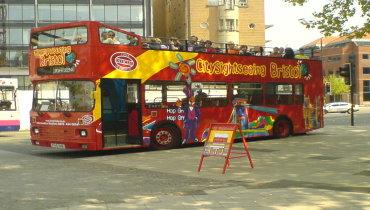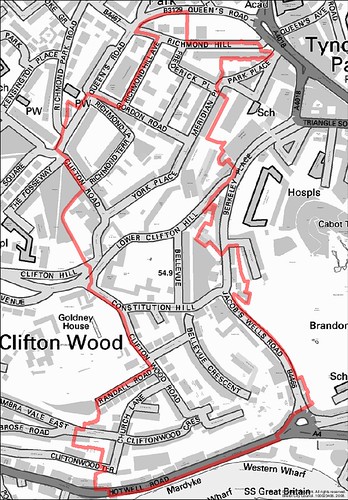
I was rather surprised at the time that no one commented, but all things come to he who waits and the bright intellects of Bristol university finally responded last week. Of course the comments, languishing in the backwaters of this blog, have gone largely unnoticed so I thought it would be fair to give them due prominence by copying them forward to this post.

First to post a comment was Matt Fortnam (above), a Bristol University research assistant and founder, no less, of the ecojam website, a vapid piece of pale greenery trying to insinuate itself into some pole position amongst Bristol's green websites. Matt writes -
Dear Chris,Then Vala Ragnarsdottir herself posted. Vala, as mentioned by Matt, is shortly returning to Iceland to teach her kinfolk about sustainability (just what they need right now) and is anxious to flog off her £240,000 trendy loft apartment (below) down at George Ferguson's Paintworks (another Ferguson link - don't you just love serendipity?).
I was upset to read this blog post. I have often enjoyed your postings but I feel this was entirely unnecessary.
Ecojam has only publicly been launched in the last month. The blog postings you refer to were included as test entries and in fact the date June 9th has no relevance to the posting. I accept full responsibility for that.
Ecojam is a new endeavour and as such the blogs are in their early stages of development. I'm not sure if lampooning new, inexperienced bloggers is an appropriate tactic. You will certainly alienate others from getting involved.
To view this, only weeks before Vala leaves for her homeland of Iceland is deplorable. Vala has been a huge inspiration and force behind the sustainability agenda in Bristol, dedicating tireless hours to the city. After years of campaigning she has finally made the University of Bristol stand up to the sustainability challenge. Only on Wednesday, the cross departmental BRITE initiative began; research that could lead to real change in Bristol and beyond. In the city, she established the Bristol Sustainability Cafes which has engaged several hundred citizens, academics, business people and decision makers. This vision has been adopted by the Bristol Partnership's Green Capital initiative. Ecojam owes a huge debt of gratitude to Vala for her continued support, as do countless other initiatives in the city. In the Department of Earth Sciences, through her sustainable futures course, many students have become enthused by environmental issues. Another legacy she is leaving.
I could go on and on.
If anyone is to blame for a boring blog it is me. I have now closed her blog.
Kind regards,
Matt

Vala, I should add, is, like George Ferguson, another of Bristol's 'Greenerati', that bunch of mainly ex public school types who have carved out their comfortable little environmental niches over the decades, busily scratching each other's backs with awards and honours.
Vala wrote-
Wow, to be singled out as the most boing blogger in Bristol is in itself an achievement!So now we know who was behind Bristol's risible designation as Britain's Greenest City and its shortlisting for European Green Crapital. And she really believes all that bull-shit! I guess that comes of an academic career where you never have to engage with the real world.
I agree that environmentalists are an easy target to attack when it comes to flying. But I assure you that every flight I book is only done I feel that my presence at whatever meeting I´m invited to will make a difference. When traveling in Europe I take the train, even to Venice.
Earlier this year I attempted to turn down an invitation to Sweden on the account that my carbon footprint was too large - to which my colleague responded: Your work on soil sustainability and creating sustainable communities is so important that you should never worry about your carbon footprint...
That comment can of course be debated.
I do not take holidays that need flights.
I´m about to move to Iceland where I will attempt to influence the local community to live more sustainably - based on the success of the Sustainability Cafes that I have organised in Bristol since 2006.
These outcomes have been adopted by the Green Capital Momentum Group (of which I am a member) as the vision for sustainable Bristol.
The Bristol Sustainability Networks was also founded as a result of these cafes and after that ecojam.org was developed by my research assistant Matt Fortnam, linking over a thousand ´green´activists and companies in the city.
Ideas developed in the Sustainability Cafes were also included in the Bristol Green EU Capital bid this September, for which Bristol now has been short-listed along with 7 other European cities.
Bristol has now been deemed to be the most sustainble city in the UK.
I do not claim these successes personally, but I have been involved with a large number of fantastic people in Bristol that have worked hard to green the image of the city and increase the well-being of its citizen.
Lastly, this week a BriTE Futures Institute was launched at the University of Bristol - which will work on finding sustainability solutions for the 21st century.
Good luck Bristol in your green quests in the future!


























I unlike the blogger or some others am not shocked that a developer, of whatever shade of green or none, should do his best to secure the best deal for his development.
It happens all the time and I would be surprised if any developer were not trying to lobby. It is the council officers job to act in line with council policy and in the interests of Bristol residents.
Three things though are being suggested
1 That council policy has not been followed. There is genuine concern here and whilst it has been common practice for many years at Bristol CC it is not acceptable and it does undermine political accountability. It has been confirmed that the piece of land was part of the green space strategy and I have confirmation that no exceptions were written in to the plan. (This was in answer to queries about Filwood park)
2 That the action is not in the interests of residents. The point of loss of accountability is that it becomes almost impossible to test this.
3 Something illegal has occurred. I have seen no evidence of this but would support openness as a matter of principle. Getting basic information out of this administration is a real problem , even for a determined questioner like myself, and a secretive administration will inevitably become a bad one even if it does not start that way.